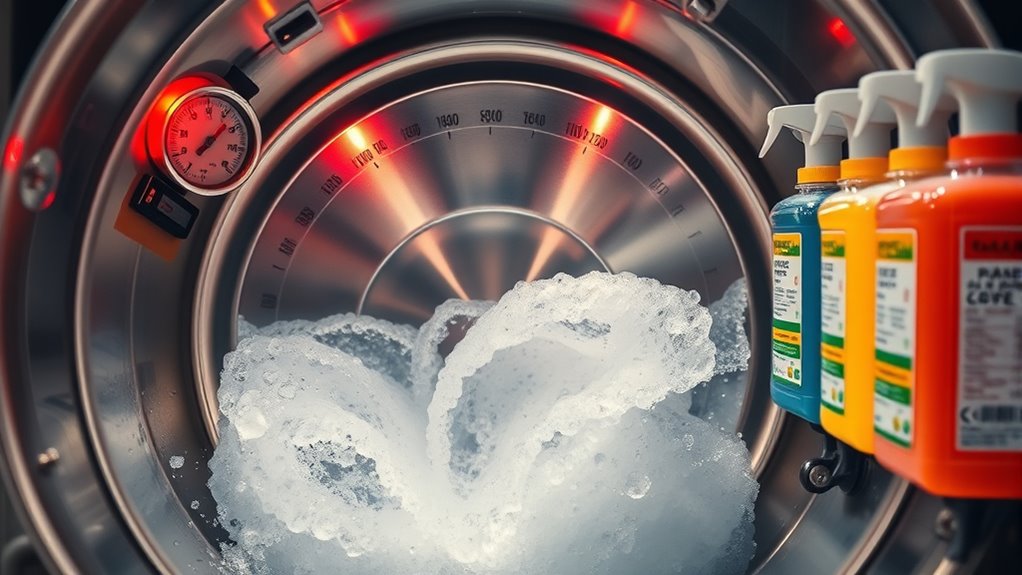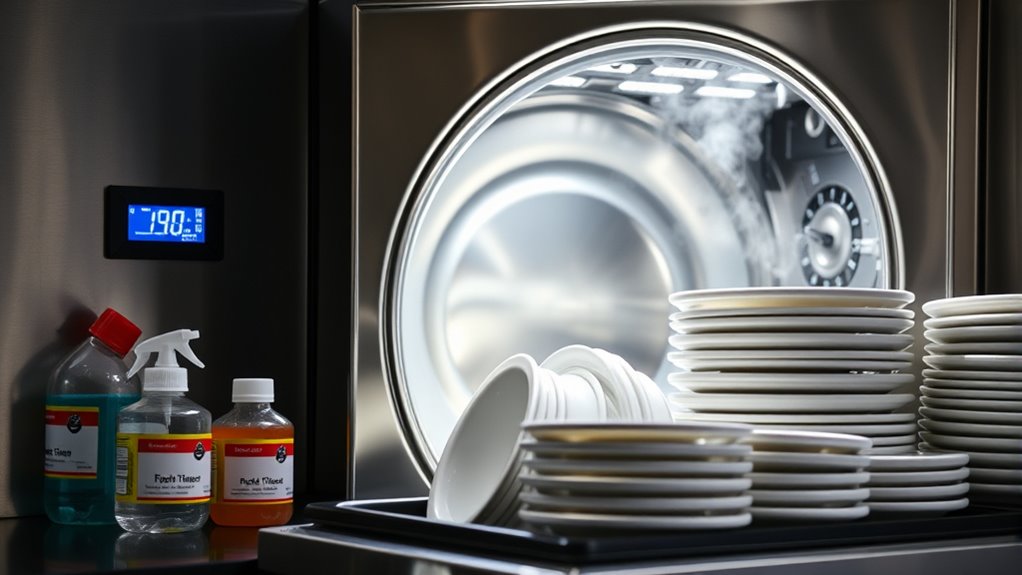To ensure proper dishmachine sanitation, maintaining the right water temperature is key. You should guarantee the water reaches at least 150°F (65°C) to help dissolve grease and support chemical sanitizers. Too low a temperature can leave residues and bacteria, while too high can damage dishes and equipment. Combining proper temperature with the correct amount of sanitizer ensures effective cleaning and sterilization. Keep exploring to discover how to optimize these elements for top-quality results.
Key Takeaways
- Proper water temperature (at least 150°F) is essential for effective grease removal and bacterial control during dishwashing.
- Insufficient temperature can hinder chemical sanitizer effectiveness and lead to residue buildup.
- Excessively high water temperatures risk damaging dishes, equipment, and pose safety hazards for staff.
- Monitoring and adjusting water temperature ensures optimal cleaning and supports compliance with health standards.
- Temperature works synergistically with chemical sanitizers to ensure dishes are thoroughly sanitized and safe for use.

Maintaining proper sanitation for dishmachines is essential to guarantee clean, safe dishes and prevent foodborne illnesses. One of the most critical factors in achieving this is understanding how water temperature influences the cleaning process. Proper water temperature ensures that the dishmachine effectively removes grease, grime, and bacteria. Typically, the water temperature should reach at least 150°F (65°C) during the wash cycle to ensure ideal cleaning. If the water isn’t hot enough, it won’t fully dissolve or loosen food particles and grease, leading to residue buildup and potential bacterial growth. Conversely, temperatures that are too high can damage dishes or equipment and pose safety risks to staff. Regularly monitoring and adjusting the water temperature guarantees that you’re maintaining the right balance to maximize cleaning efficiency. Ensuring the correct temperature also supports effective sanitization protocols and compliance with health standards.
Frequently Asked Questions
How Do I Troubleshoot Inconsistent Cleaning Results?
To troubleshoot inconsistent cleaning results, start by checking your dishwasher maintenance and ensuring it’s functioning properly. Review your cleaning schedules to confirm they’re being followed consistently. Inspect the temperature settings, chemical levels, and spray arms for blockages or buildup. Regularly calibrate the machine, and clean filters and nozzles. Proper maintenance and adherence to schedules help maintain peak performance, ensuring dishes come out spotless every time.
What Are the Environmental Impacts of Chemical Sanitizers?
Imagine vibrant rivers tainted by chemical runoff, showing the environmental impact of sanitizers. You should be aware that chemical sanitizers can harm aquatic life and disrupt ecosystems if not used properly. Excess chemicals may leach into groundwater or be carried into waterways, causing pollution. By choosing eco-friendly options and managing proper disposal, you help reduce environmental impact, ensuring cleaner water and healthier surroundings for everyone.
Can High Temperatures Damage Dishmachine Components?
Yes, high temperatures can damage dishmachine components. When you don’t regulate temperature properly, it can lead to overheating, causing wear and tear on parts like gaskets and seals. Proper temperature regulation guarantees chemical effectiveness without risking damage. By maintaining the right temperature, you protect your dishmachine and keep it running efficiently, preventing costly repairs and ensuring safe, hygienic dishwashing.
How Often Should I Calibrate Temperature Controls?
You should calibrate your dishmachine’s temperature controls at least once every three months to guarantee temperature accuracy. While some might worry this is excessive, regular calibration prevents sanitation issues caused by inaccurate readings. If your machine sees heavy use or if you notice inconsistent wash results, consider more frequent calibration. Keeping a schedule maintains peak sanitation, extending your machine’s lifespan and ensuring safe, hygienic dishwashing every time.
Are There Health Risks Associated With Chemical Residues?
Chemical residue concerns can pose health risks if not properly managed, so you should always prioritize thorough rinsing and proper chemical use. Conduct a health risk assessment regularly to identify potential issues. If residues remain on dishes, they could cause allergic reactions or other health problems. By following manufacturer instructions and ensuring proper sanitation procedures, you minimize chemical residue risks, protecting both staff and customers from possible health hazards.
Conclusion
Maintaining proper dishmachine sanitation is essential, whether you rely on temperature or chemicals. Did you know that 85% of restaurant-related illnesses are linked to inadequate sanitation? By ensuring your machine reaches the right temperature or uses effective chemicals, you protect your customers and staff. Remember, combining both methods often yields the best results. Keep these practices in mind, and you’ll keep your kitchen safe and compliant with health standards every time.









